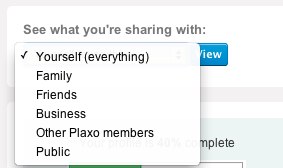A while back, I posted a rant about information architecture that invoked the term “cyberspace.” I, of course, received some flack for using that word. It’s played out, people say. It invokes dusty 80s-90s “virtual reality” ideas about a separate plane of existence … Tron-like cyber-city vistas, bulky goggles & body-suits, and dystopian worlds. Ok…yeah, whatever. For most people that’s probably true.
So let’s start from a different angle …
Over the last 20 years or so, we’ve managed to cause the emergence of a massive, global, networked dimension of human experience, enabled by digital technology.
It’s the dimension you visit when you’re sitting in the coffee shop catching up on your Twitter or Facebook feed. You’re “here” in the sense of sitting in the coffee shop. But you’re also “there” in the sense of “hanging out ‘on’ <Twitter/Facebook/Whatever>.”
It’s the dimension brave, unhappy citizens of Libya are “visiting” when they read, in real-time, the real words of regular people in Tunisia and Egypt, that inspire them to action just as powerfully as if those people were protesting right next to them. It may not be the dimension where these people physically march and bleed, but it’s definitely one dimension where the marching and bleeding matter.
I say “dimension” because for me that word doesn’t imply mutual exclusivity between “physical” and “virtual”: you can be in more than one “dimension” at once. It’s a facet of reality, but a facet that runs the length and breadth of that reality. The word “layer” doesn’t work, because “layer” implies a separate stratum. (Even though I’ve used “layer” off and on for a long time too…)
This dimension isn’t carbon-based, but information-based. It’s specifically human, because it’s made for, and bound together with, human semantics and cognition. It’s the place where “knowledge work” mostly happens. But it’s also the place where, more and more, our stories live, and where we look to make sense of our lives and our relationships.
What do we call this thing?
Back in 2006, Wired Magazine had a feature on how “Cyberspace is Dead.” They made the same points about the term that I mention above, and asked some well-known futurist-types to come up with a new term. But none of the terms they mentioned have seemed to stick. One person suggests “infosphere” … and I myself tried terms like “infospace” in the past. But I don’t hear anyone using those words now.
Even “ubiquitous computing” (Vint Cerf’s suggestion, but the late Mark Weiser’s coinage) has remained a specialized term of art within a relatively small community. Plus, honestly, it doesn’t capture the dimensionality I describe above … it’s fine as a term for the activity of “computing” (hello, antiquated terminology) from anywhere, and for reminding us that computing technology is ubiquitously present, but doesn’t help us talk about the “where” that emerges from this activity.
There have been excellent books about this sort of dimension, with titles like Everyware, Here Comes Everybody, Linked, Ambient Findability, Smart Things … books with a lot of great ideas, but without a settled term for this thing we’ve made.
Of course, this begs the question: why do we need a term for it? As one of the people quoted in the Wired article says, aren’t we now just talking about “life”? Yeah, maybe that’s OK for most people. We used to say “e-business” because it was important to distinguish internet-based business from regular business … but in only a few years, that distinction has been effaced to meaninglessness. What business *isn’t* now networked in some way?
Still, for people like me who are tasked with designing the frameworks — the rule sets and semantic structures, the links and cross-experiential contexts, I think it’s helpful to have a term of art for this dimension … because it behaves differently from the legacy space we inherited.
It’s important to be able to point at this dimension as a distinct facet of the reality we’re creating, so we can talk about its nature and how best to design for it. Otherwise, we go about making things using assumptions hardwired into our brains from millions of years of physical evolution, and miss out on the particular power (and overlook the dangers) of this new dimension.
So, maybe let’s take a second look at “cyberspace” … could it be redeemed?
At the Institute for the Future, there’s a paper called “Blended Reality” (yet another phrase that hasn’t caught on). In the abstract, there’s a nicely phrased statement [emphasis mine]:
We are creating a new kind of reality, one in which physical and digital environments, media, and interactions are woven together throughout our daily lives. In this world, the virtual and the physical are seamlessly integrated. Cyberspace is not a destination; rather, it is a layer tightly integrated into the world around us.
The writer who coined the term, William Gibson, was quoted in the “Cyberspace is Dead” piece as saying, “I think cyberspace is past its sell-by, but the problem is that everything has become an aspect of, well, cyberspace.” This strikes me, frankly, as a polite way of saying “yeah I get your point, but I don’t think you get what I mean these days by the term.” Or, another paraphrase: I agree the way people generally understand the term is dated and feels, well, spoiled like milk … but maybe you need to understand that’s not cyberspace …”
Personally, I think Gibson sees the neon-cyberpunk-cityscape, virtual-reality conception of cyberspace as pretty far off the mark. In articles and interviews I’ve read over the years, he’s referenced it on and off … but seems conscious of the fact that people will misunderstand it, and finds himself explaining his points with other language.
Frankly, though, we haven’t listened closely enough. In the same magazine as the “Cyberspace is Dead” article, seven years prior, Gibson posted what I posit to be one of the foundational texts for understanding this… whatever … we’ve wrought. It’s an essay about his experience with purchasing antique watches on eBay, called “My Obsession.” I challenge anyone to read this piece and then come up with a better term for what he describes.
It’s beautiful … so read the whole thing. But I’m going to quote the last portion here in full:
In Istanbul, one chill misty morning in 1970, I stood in Kapali Carsi, the grand bazaar, under a Sony sign bristling with alien futurity, and stared deep into a cube of plate glass filled with tiny, ancient, fascinating things.
Hanging in that ancient venue, a place whose on-site café, I was told, had been open, 24 hours a day, 365 days a year, literally for centuries, the Sony sign – very large, very proto-Blade Runner, illuminated in some way I hadn’t seen before – made a deep impression. I’d been living on a Greek island, an archaeological protectorate where cars were prohibited, vacationing in the past.
The glass cube was one man’s shop. He was a dealer in curios, and from within it he would reluctantly fetch, like the human equivalent of those robotic cranes in amusement arcades, objects I indicated that I wished to examine. He used a long pair of spring-loaded faux-ivory chopsticks, antiques themselves, their warped tips lent traction by wrappings of rubber bands.
And with these he plucked up, and I purchased, a single stone bead of great beauty, the color of apricot, with bright mineral blood at its core, to make a necklace for the girl I’d later marry, and an excessively mechanical Swiss cigarette lighter, circa 1911 or so, broken, its hallmarked silver case crudely soldered with strange, Eastern, aftermarket sigils.
And in that moment, I think, were all the elements of a real futurity: all the elements of the world toward which we were heading – an emerging technology, a map that was about to evert, to swallow the territory it represented. The technology that sign foreshadowed would become the venue, the city itself. And the bazaar within it.
But I’m glad we still have a place for things to change hands. Even here, in this territory the map became.
I’ve written before about how the map has become the territory. But I’d completely forgotten, until today, this piece I read over 10 years ago. Fitting, I suppose, that I should rediscover it now by typing a few words into Google, trying to find an article I vaguely remembered reading once about Gibson and eBay. As he says earlier in the piece quoted above, “We are mapping literally everything, from the human genome to Jaeger two-register chronographs, and our search engines grind increasingly fine.”
Names are important, powerful things. We need a name for this dimension that is the map turned out from itself, to be its own territorial reality. I’m not married to “cyberspace” — I’ll gladly call it something else.
What’s important to me is that we have a way to talk about it, so we can get better at the work of designing and making for it, and within it.
Note: Thanks to Andrea Resmini & Luca Rosati for involving me in their work on the upcoming book, Pervasive IA, from which I gleaned the reference to the Institute for the Future article I mentioned above.




